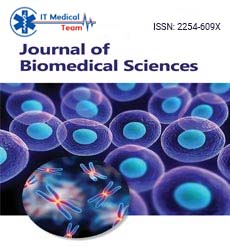Commentary - (2024) Volume 13, Issue 3
Exploring Tropical Medicine: Understanding Diseases of the Tropics
Giuseppe Cannataro*
Department of Medicine, University of Milan, Italy
*Correspondence:
Giuseppe Cannataro, Department of Medicine, University of Milan,
Italy,
Email:
Received: 17-May-2024, Manuscript No. IPJBS-24-14872;
Editor assigned: 20-May-2024, Pre QC No. IPJBS-24-14872 (PQ);
Reviewed: 03-Jun-2024, QC No. IPJBS-24-14872;
Revised: 11-Jun-2024, Manuscript No. IPJBS-24-14872 (R);
Published:
19-Jun-2024
Description
Tropical medicine is a specialized branch of medicine that
focuses on the prevention, diagnosis, and treatment of diseases
that are prevalent in tropical and subtropical regions of the
world. These diseases are often referred to as Neglected Tropical
Diseases (NTDs) and primarily affect populations in low and
middle-income countries, where access to healthcare and
resources may be limited. This article delves into the unique
challenges and key aspects of tropical medicine, shedding light
on the efforts to combat these diseases and improve global
health outcomes.
The scope of tropical medicine
Tropical medicine encompasses a wide range of diseases,
many of which are caused by parasites, bacteria, viruses, and
other pathogens. These diseases thrive in warm and humid
climates and are often transmitted by vectors such as
mosquitoes, flies, and snails. Some of the most common tropical
diseases include:
Malaria: Malaria is a life-threatening disease caused by Plasmodium parasites, which are transmitted to humans
through the bite of infected Anopheles mosquitoes. It is
characterized by symptoms such as fever, chills, headache, and
vomiting and can lead to severe complications if not treated
promptly.
Dengue fever: Dengue fever is a viral infection transmitted by
Aedes mosquitoes, causing flu-like symptoms such as high fever,
severe headache, joint and muscle pain, rash, and in severe
cases, hemorrhagic fever or dengue shock syndrome.
Chikungunya: Chikungunya is another viral disease spread by
Aedes mosquitoes, characterized by fever, joint pain, muscle
pain, headache, nausea, fatigue, and rash. While rarely fatal, it
can cause debilitating symptoms that last for weeks or months.
Schistosomiasis: Schistosomiasis is a parasitic infection
caused by blood flukes of the genus Schistosoma, which are
transmitted through contaminated water. Chronic infection can
lead to organ damage, including liver and spleen enlargement,
and increase the risk of bladder cancer.
Neglected Tropical Diseases (NTDs): NTDs encompass a group
of infectious diseases that primarily affect populations living in
poverty, including lymphatic filariasis, onchocerciasis (river
blindness), soil-transmitted helminthiasis, and others. These
diseases often cause chronic disability and contribute to the
cycle of poverty in affected communities.
Challenges in tropical medicine
Tropical medicine presents unique challenges due to the
complex interactions between environmental, social, and
biological factors. Some of these challenges include:
Limited access to healthcare: Many tropical regions lack
adequate healthcare infrastructure, trained medical personnel,
and resources to effectively prevent, diagnose, and treat
diseases.
Vector control: Controlling disease vectors such as mosquitoes
requires comprehensive strategies, including insecticide-treated
bed nets, indoor residual spraying, environmental management,
and community education.
Drug resistance: The emergence of drug-resistant strains of
pathogens, such as malaria parasites and bacteria causing
tuberculosis, poses a significant threat to disease control efforts
in tropical regions.
Climate change: Climate change is altering the distribution
and behavior of disease vectors, increasing the risk of disease
transmission in new areas and challenging existing control
measures.
Poverty and social determinants of health: Poverty,
inadequate sanitation, lack of clean water, and other social
determinants of health contribute to the burden of tropical
diseases and hinder efforts to control and eliminate them.
Approaches to disease control and prevention
Despite the challenges, significant progress has been made in
the field of tropical medicine through collaborative efforts
between governments, international organizations, Non-Governmental Organizations (NGOs), and research institutions.
Key approaches to disease control and prevention include:
Vector control programs: Implementing vector control
measures such as insecticide-treated bed nets, indoor residual
spraying, larval control, and environmental management to
reduce the transmission of mosquito-borne diseases like
malaria, dengue, and chikungunya.
Mass drug administration: Providing preventive chemotherapy
to at-risk populations through mass drug administration programs
for diseases such as lymphatic filariasis, onchocerciasis, and soil-transmitted helminthiasis.
Improved access to healthcare: Strengthening healthcare
systems, training healthcare workers, and expanding access to
essential medicines and diagnostics to ensure early diagnosis
and prompt treatment of tropical diseases.
Vaccine development: Developing vaccines against tropical
diseases such as malaria, dengue, and schistosomiasis to prevent
infection and reduce disease burden.
Community engagement and education: Empowering
communities through education, behavior change interventions,
and community-led initiatives to promote hygiene, sanitation,
and preventive practices.
The future of tropical medicine
Advances in science and technology, along with increased
global awareness and funding for tropical diseases, offer hope
for further progress in the field of tropical medicine. Continued
research into the biology of pathogens, development of new
diagnostics and treatments, and innovative approaches to
disease control and prevention will be crucial in addressing the
challenges of tropical diseases and improving health outcomes
for vulnerable populations.
In conclusion, tropical medicine plays a vital role in addressing
the unique health challenges faced by populations in tropical
and subtropical regions. By focusing on disease prevention,
diagnosis, and treatment, and addressing underlying social and
environmental factors, the field of tropical medicine aims to
reduce the burden of disease and improve the health and well-being of millions of people worldwide.
Citation: Cannataro G (2024) Exploring Tropical Medicine: Understanding Diseases of the Tropics. J Biomed Sci Vol:13 No:3





